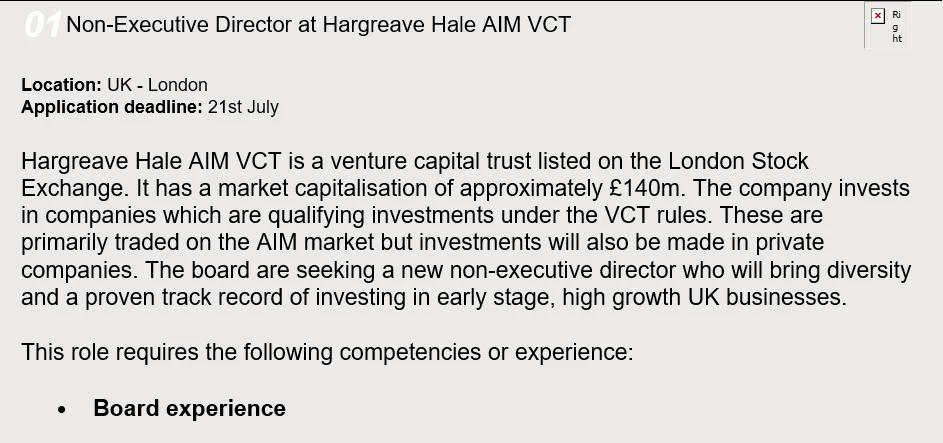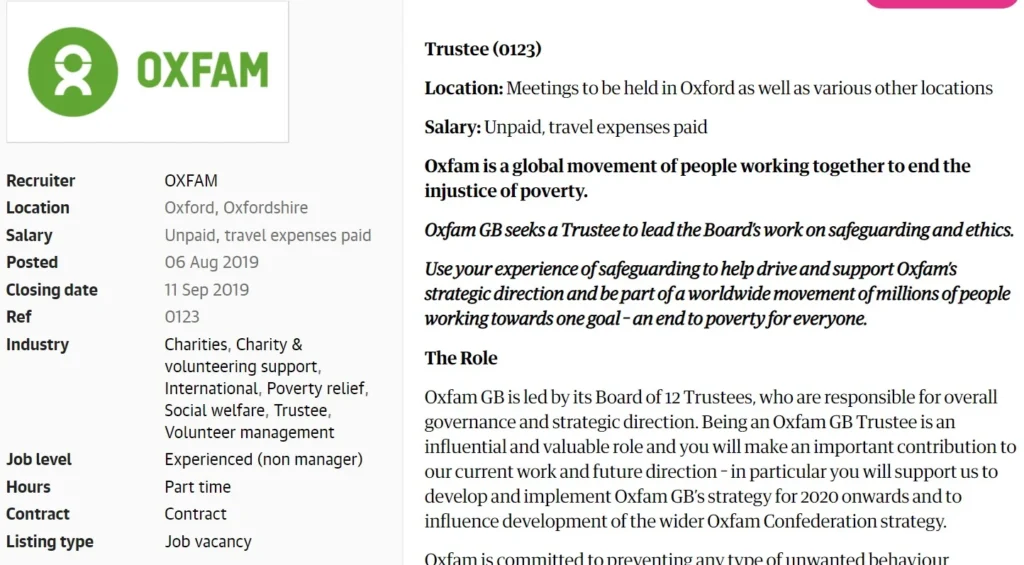Golden nuggets to write a winning CV for unretirement
22 August 2019 By Victoria Tomlinson

I have been sent four CVs in the last ten days – all for people aged 50+ who are actively looking for new roles for the first time in nearly 30 years.
Studies show that headhunters and others scan a CV for six seconds before rejecting or deciding to read on. I don’t think any of these would have made it on to the possible or even yes piles.
This is understandable – it is years since most successful people have written a CV and time and again people say this is one of the hardest things to do once you leave corporate life.
So let’s look at where these CVs are going wrong and how to write a CV that will land you the role you want. (And this is one of our services, so if it is too daunting to do on your own, we can help. Click below to book this)
What do you want the CV to achieve?
All of the recent CVs were narratives of (long) careers. They did not pull out their skills that would match the roles they are looking for – which varied between non-executive roles to part-time finance director and a growth adviser.
To be successful you have to
- Be clear about the role that your CV is written for
- Analyse the skills and achievements that will be needed for that role
- Write the CV to bring out those points
Achievements vs what you have done
Years ago, I had help from a boss on my own CV who said, “You have said you were captain of the hockey team, not – I took the team from bottom of the league to winning the regional cup”.
I should say I am the least sporty person in the world, and never made even the third hockey team, let alone captained anything! Much to my disappointment.
But you will get the idea of what he was saying.
An example of one of the CVs I have been looking at explains their skills in these sort of words
‘My areas of expertise include
- Financial management & strategic planning
- Operational management & systems implementation
… Responsible for P&L, balance sheet, budgets and forecasts’
What’s wrong with this? In this example, the person has been finance director for 20 years, so all of this should be a given? And they are specifically looking for a part-time FD role, so what you probably want to see are things on the lines of
- Ability and evidence of building relationships. In the role of part-time FD you might only be going into the business one day a week – or even month. You will have to win the trust of the leadership team, those reporting to you and in the wider business, so you understand the risks and people come to you with issues
- Your role in growing the company – in this example, the person was FD during the period of growing the business from a small subsidiary to a highly successful multi-million pound business which was sold. But there was nothing in the CV to explain the role they played in this. You would want to see things like
- Tripled profits in three years, transforming from a deficit to beating all industry benchmarks
- Successfully managed cashflow through a critical period when the company lost a major customer due to recession
- Won support of the leadership team to delay investments, ensuring financial stability
- Negotiated increasingly good deals with funders, going from initial x% rate to y% and winning bank’s trust to do xyz
I am guessing and making up these things, but suddenly you have a sense of the person’s skills and most of all, others will think – that’s the person we want on our team.
A list of what you were responsible for doesn’t bring you, the person, to life. The reader has no idea where your skills really lie and how these could apply to other roles. You have to give yourself a distinctive personal brand.
Non-executive vs executive
The big change for people looking for non-executive or advisory roles, is that you need to write a non-executive CV. And that means showing that you understand and can demonstrate non-executive skills – such as taking tough governance decisions. You may only have been a school governor, but you want to pull something out from that if you can. And show that you have experience in and understand how to influence from the side, rather than as an executive when you were making the decisions (I included examples of this in a guest blog I wrote some years ago on 9 Lessons of Being a Non-executive Director).
A good non-executive CV typically has your non-executive experience and roles on the front page and your executive career summarised on the second page.
What skills are chairs looking for?
There is a helpful article by Ian Wright, A Masterclass in Finding Non-executive Director Positions – he has recruited non-executive directors for 15 years. In his experience, he says that chairs (who after all, are the ones doing the briefing and appointing) are looking for
- Governance experience
- Demonstrable passion for the business/sector
- Your network and connections
- Executive skills
- Cultural and personality fit with the management team
He goes on to say, “Out of all of the above, I would strongly argue that the most important of these (at least in the SME market) is your ability to utilise your connections and network for a commercial gain.”
When I have interviewed people with a portfolio of non-executive roles, the recurring theme behind their success is that they all spent time meeting (and listening to) a lot of headhunters, but also a lot of chairs and other non-execs. This was to understand what roles were going in the market, what skills were needed and how they positioned themselves for these. A lot have talked about the disappointment that their own skills and experience (as they saw them) were not in themselves useful – time and again, headhunters pointed out this is a crowded market-place and to win those roles you really need to stand out.
Your CV is just a part of this. It is not the be all and end all but if you are applying cold for roles (ideally you won’t be, but how you avoid that is for another time!) your CV has to achieve a lot, quickly.
Once you understand the roles that you have a chance of getting and the skills/experience needed for them, you can then write your CV to bring out these aspects.
Tailor, tailor, tailor
The golden rule when applying for any position is to tailor your CV to the specific role. One size will not fit all.
This all sounds obvious but very few people do this.
Let’s take a non-executive role posted earlier this year

For this, you need to start your CV summary with a bang – ‘I am relevant’. Something like ‘An experienced board director – both as chief executive and non-executive director – with a track record of growing businesses from early stage to AIM listings.’ That covers all the essentials in the job advertisement, in the first line. You might make the ‘possible’ pile at least. If you can show how you bring diversity, even better.
Your CV then needs to give the evidence of the businesses you have taken from early stage to high growth – adding figures and timescales – and demonstrate your role in those achievements.
Looking at a very different example, this is an advertisement for a trustee for Oxfam – on safeguarding and ethics. It is important to research any organisation you are applying to – Oxfam sacked 43 people in March 2019 because of safeguarding concerns. This trustee role is almost certainly in response to the scandals that have emerged and the need to address – and publicly be seen to be addressing – widespread sexual harassment claims.

For this role, you want to start your CV with a paragraph on the lines of “A respected leader who has led the cultural transformation of xyz, reducing the number of sexual harassment claims from five a year six years ago to none in the last two years.”
Interestingly you could be the same person applying for both the jobs above. You may have worked in high growth businesses, but also have been the executive lead addressing a #MeToo issue.
Evidence, evidence, evidence
When you have decided what skills boards need – that you can help with – the next step is to write these down and then list out the evidence you have to demonstrate your achievements in these areas.
One of the CVs I have been looking at has a paragraph in the summary, “When clients unfortunately had financial problems that could not be resolved I worked with them and appropriate insolvency experts in order to resolve the situation in the best way for all parties.” It could be phrased more tightly but either way, the headhunter or chairman is then going to want to see the evidence of this – which was missing here.
You would want to see something like,
‘Helped turnaround 30 businesses, working with network of 200+ professionals in banking, insolvency, credit finance, legal, property, employment and intellectual property. Returned 10 businesses to a going concern, found buyers for six and liquidated the remainder’
This approach does several things – you are giving the evidence of what you have done and your success rates, proving the specific. You are demonstrating a wide network – which as Ian Wright says, is one of the things that many boards are looking for. And you are showing that you have a wide range of experience in areas from employment to credit finance in addition to your main role.
Understand the current issues worrying boards
The Oxfam advertisement above is an excellent example of how boards recruit to address new issues. At the moment, these include everything from cybersecurity, data security and failure of IT systems (think British Airlines and TSB) to culture change (#MeToo) and ethics (Tesco and Patisserie Valerie).
The above advertisements have words and phrases that you need to include in your tailored CV. But your own conversations and discussions with chairs and headhunters should pull out what boards are worried about, to include in your generic CV. Things you might overlook – such as having led a successful campaign to increase the number of female directors in your firm – could actually unlock opportunities for some board roles.
If you are now looking at your CV and thinking ‘it needs rewriting’, we would love to help you. Click here and book in for the CV support – which you can combine with writing your LinkedIn at the same time, if you want.
I hope this blog will help you on your journey – but also reassure you that this is not an easy task and you are not alone!


